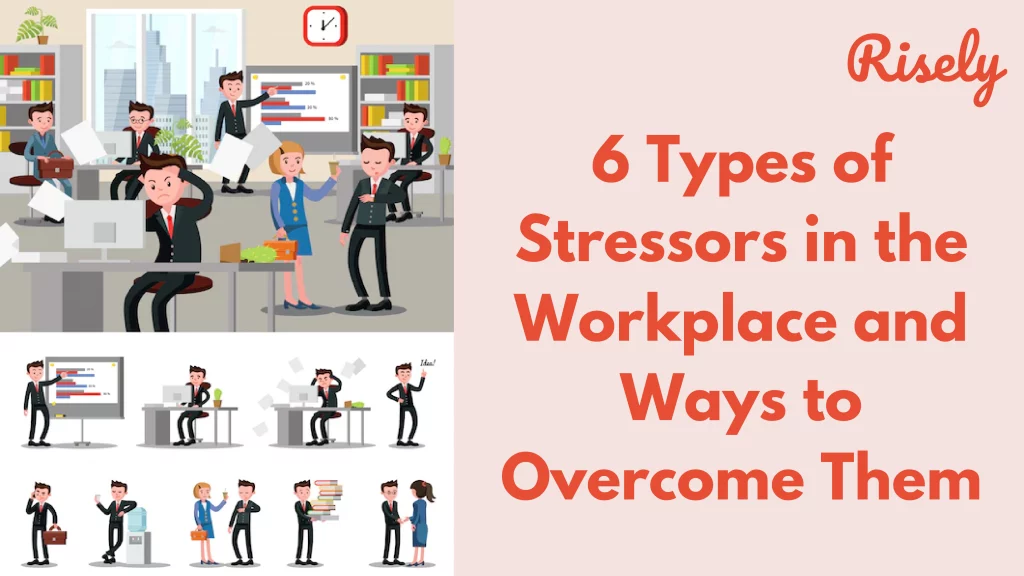Stress is considered a normal part of everyday life, but its impact can be detrimental when it comes to the workplace. Workplace stressors can come in many forms and affect employees differently. In this blog post, we will discuss everything you need to know about stressors in the workplace. We will cover what they are and their categories. We’ll also provide tips for overcoming them through identifying personal stressors, implementing healthy coping mechanisms, setting boundaries, seeking support from supervisors or HR, and building a support system. By the end of this post, you’ll better understand how workplace stressors in the workplace can affect you and how to manage them effectively.
What are Stressors in the Workplace?
Stressors in the workplace refer to various factors or conditions that can cause stress or tension for individuals within their work environment. These stressors can be external factors such as work demands, organizational policies, interpersonal conflicts, and internal factors like personal expectations and perceptions. Workplace stress can encompass a wide range of elements, including excessive workloads, tight deadlines, lack of control over one’s work, conflicts with colleagues or supervisors, job insecurity, work-life imbalance, inadequate support or recognition, poor management, and unfavorable organizational culture. Read more about workplace stress here: 7 Effective Ways To Manage Stress At Work For ManagersCategories of Workplace Stressors
Workplace stressors can be broadly categorized into five main categories. It’s important to note that these categories are not mutually exclusive, and workplace stress often results from a combination of factors. Managers and their teams should strive to identify and address these stressors to promote a healthier and more productive work environment. They can also take proactive steps to manage stress, such as seeking support, practicing self-care, setting boundaries, and effectively communicating their needs.- Organizational Stressors: These stressors arise from an organization’s structure, policies, and practices. Examples include excessive workload, tight deadlines, lack of job security, insufficient resources or support, lack of control or autonomy in decision-making, unclear expectations or role ambiguity, and poor communication or feedback.
- Interpersonal Stressors: These stressors stem from interactions with coworkers, supervisors, or clients. Examples include conflicts or disagreements, bullying by managers or harassment, lack of social support, poor teamwork or collaboration, ineffective leadership, and complex or demanding relationships.
- Environmental Stressors: These stressors are related to the physical and psychosocial aspects of the work environment. Examples include excessive noise, poor lighting or ventilation, uncomfortable temperatures, crowded or insufficient workspace, safety hazards, and exposure to pollutants or toxins.
- Work-Life Balance Stressors: These stressors arise when there is an imbalance between work and personal life responsibilities. Examples include long working hours, inflexible schedules, lack of control over time, excessive travel or commuting, conflicting work and family demands, and inadequate opportunities for relaxation or leisure.
- Occupational Hazards: These stressors are associated with specific occupations or industries and pose a risk to employees’ physical or psychological well-being. Examples include exposure to dangerous substances, physical hazards (e.g., lifting heavy objects), high-stress situations (e.g., emergency responders), job-related trauma (e.g., first responders or military personnel), and emotional demands (e.g., healthcare professionals).
- Normative stressors: Normative stressors refer to the stressors that are commonly experienced in a particular profession or industry. These stressors are inherent to the nature of the job and are often considered “normal” or expected within that context. Normative stressors can vary across cultures and societies, but they are generally part of life and are experienced by many people.
Other Interesting Reads
Overcoming Workplace Stressors
Overcoming workplace stressors can be daunting, but it is essential for maintaining your mental and physical well-being. One of the first steps to overcoming stressors is identifying the source of stress in your workplace. For example, is it related to workload or work relationships? Once you have identified the primary stressor, take proactive steps to address it directly. To overcome stressors in the workplace, here are some strategies and examples that would come in handy for you:Organizational Stressors:
- Prioritize and delegate tasks: If you have an excessive workload, discuss with your supervisor to identify priorities and delegate tasks to alleviate the burden.
- Seek clarification: If you experience role ambiguity or unclear expectations, communicate with your supervisor or colleagues to clarify your responsibilities and objectives.
- Improve communication: If poor communication contributes to stress, suggest regular team meetings, clear email guidelines, or project management tools to enhance communication channels.
Interpersonal Stressors:
- Address conflicts directly: If you have conflicts with a coworker, try resolving the issue through open and respectful communication. Seek mediation or involve a supervisor if needed.
- Build a support network: Cultivate positive relationships with colleagues who provide support and camaraderie, fostering a healthy work environment.
- Seek guidance: If you face challenges with a supervisor, consider seeking mentorship from someone higher in the organization or discussing concerns with Human Resources.
Environmental Stressors:
- Create a pleasant workspace: Personalize it with plants, photos, or calming elements to make it more comfortable and inviting.
- Utilize breaks effectively: Take short breaks to step outside, stretch, or engage in relaxation techniques to counteract the effects of a stressful environment.
- Advocate for improvements: If you identify specific environmental stressors, such as excessive noise or poor lighting, communicate these concerns to facilities or relevant departments.
Work-Life Balance Stressors:
- Establish boundaries: Clearly define and communicate your boundaries to your colleagues, avoiding excessive overtime or taking work home.
- Prioritize self-care: Engage in activities that promote relaxation, such as exercise, hobbies, or spending quality time with loved ones, to recharge outside of work.
- Utilize flexible work options: Explore opportunities for flexible scheduling, remote work, or part-time arrangements to better balance work and personal obligations.
Occupational Hazards:
- Practice self-care and stress management: Engage in stress-reducing activities like meditation, deep breathing exercises, or mindfulness techniques to cope with high-stress occupations.
- Utilize protective equipment: If your job involves physical hazards or substance exposure, ensure you have the necessary personal protective equipment (PPE) and follow safety protocols.
- Seek professional support: Consider seeking counseling or therapy to address the psychological impact and develop coping strategies for occupations involving trauma or high emotional demands.
Normative stressors:
- Prioritize and manage workload: you can break tasks into smaller, manageable steps and communicate with supervisors to negotiate realistic deadlines.
- Develop healthy coping mechanisms: Engage in stress-reducing activities outside of work and seek support from colleagues or professional networks.
Conclusion
Workplace stressors are a common occurrence that can have negative impacts on your physical, emotional, and mental health. Identifying what causes these stressors and working towards overcoming them is essential. Remember, you are not alone in this struggle; many employees face similar issues. Take the time to identify your stressors and implement healthy coping mechanisms to reduce their impact on your well-being. It’s also crucial to seek support from supervisors or HR and build a support system with colleagues or friends outside of work. Finally, you can create a more productive and fulfilling work environment by prioritizing your mental health. To learn more about managing workplace stressors, check out our comprehensive guide.Test your prioritization skills now to leave behind stressors that bring chaos along.
Take the free prioritization self-assessment for managers to understand the mistakes holding you back.
Frequently Asked Questions
What are the stressors in the workplace?
Workplace stress can be anything from long working hours and tight deadlines to difficult colleagues or a toxic work environment. Stressors are any external factors that cause stress, anxiety, or tension in an individual. They can be physical, emotional, psychological, or environmental. Therefore, it is essential to identify and develop healthy coping mechanisms to manage these stressors.
What are the 5 major stressors?
The five major stressors are environmental stressors, occupational hazards, organizational stressors, interpersonal stressors, and work-life balance stressors. If not appropriately managed, these can significantly impact an individual’s mental and physical well-being. Identifying these stressors and implementing healthy coping mechanisms to reduce their impact on your life is essential. Seek support from supervisors or HR and build a support system with colleagues or friends outside of work to create a more productive and fulfilling environment for yourself.






